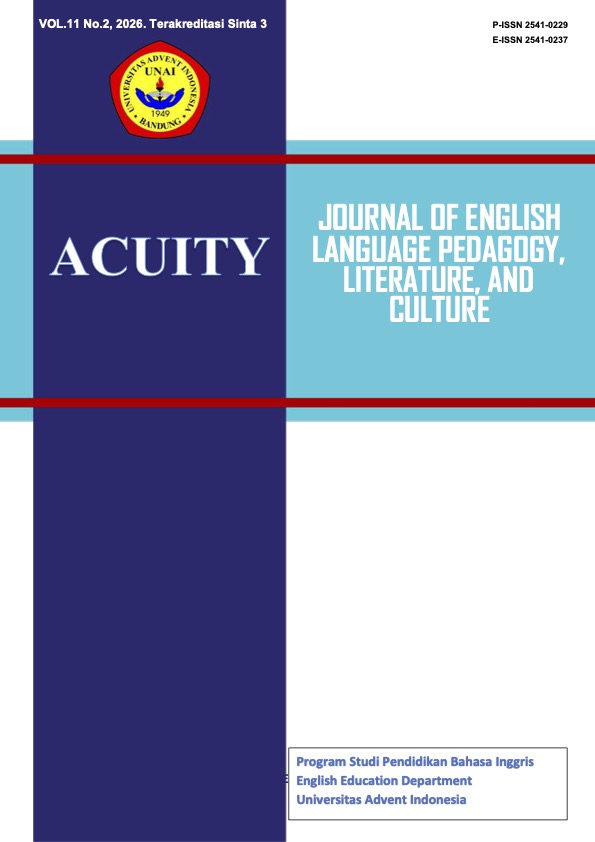Motherly Love of the Main Character in Indian Thriller Film “Mom” (2017)
Keywords:
love, film Mom, representationAbstract
The objective of this study is to describe the representation of motherly love (love a mother as the main character (Devki) to her stepdaughter (Arya) in the film Mom (2017). The author uses descriptive research which is described through the storyline in terms of dialogue and action. The analysis shows that Mother's love is represented in the form of a mother's struggle for her stepdaughter who gets sexual violence and injustice in the law. Devki, a mother wants to avenge all the criminals who have been involved in the abuse of Arya. Arya is not Devki's biological child, but she loves her very much. Devki the mother is willing to play “dirty” and hires a private detective to complete his noble mission, but Devki is not aware of another danger that threatens him. She did various ways to avenge the suffering her daughter experienced from the perpetrators. As a child, we must have often heard stories about her life suffered because of the torture of her stepmother. In this film, we see a woman as a mother with sincere affection. This film proves that not all stepchildren will end up suffering. Devki proves that she is Arya's stepmother, but her love for her daughter is not about blood relations. Although Devki did do wrong, we may have to admit it. A mother's instinct does not know the meaning of her child, adopted child, or stepchild. A person who plays the title of mother sometimes acts out of sanity for the sake of a child, but she proves that a mother will go through all her limitations to give justice and happiness to her child. Devki is willing to risk his life to give a new life to Arya. She tries to return Arya's life and smiles. Devki is an image of the strength of a mother who is full of love from a stepmother towards her stepdaughter.
Downloads
References
Altheide, D. L., & Schneider, C. J. (2012). Qualitative Media Analysis. SAGE Publications.
Andhani, W., & Putri, I. P. (2017). Representasi Peran Ibu Sebagai Single Parent Dalam Film Sabtu Bersama Bapak (analisis Semiotika John Fiske Dalam Film Sabtu Bersama Bapak). eProceedings of Management, 4(3). https://openlibrarypublications.telkomuniversity.ac.id/index.php/management/article/view/5057
Arora, T. (2020). Motherly Hug. Pen Brew Publisher.
Ayob, A. (2022). Understanding Bollywood: A Calling. Cambridge Scholars Publishing.
Bajaj, V. (2016). T is for Taj Mahal: An India Alphabet. Weigl Publishers.
Chakravorty, P. (2017). This is How We Dance Now!: Performance in the Age of Bollywood and Reality Shows. Oxford University Press.
Febriyanti, D., Ramdhani, M., & Lubis, F. M. (2020). Representasi peran Ibu dalam film Ibu Maafkan Aku. ProTVF (Jurnal Kajian Televisi Dan Film), 4(1), 105–122. https://doi.org/10.24198/ptvf.v4i1.24193
Fitria, T. N. (2020). An Analysis of Moral Values Found in a Korean TV Series ‘The World of Married’. Acuity: Journal of English Language Pedagogy, Literature and Culture, 5(2), 137–147. https://doi.org/10.35974/acuity.v5i2.2317
Fitria, T. N. (2021). Characterization Analysis of the Main Character in “Hichki” Movie. Vivid: Journal of Language and Literature, 10(1), 6–17. https://doi.org/10.25077/vj.10.1.6-17.2021
Fromm, E. (2013). The Art of Loving. Open Road Media.
Fromm, E., & Maccoby, M. (2014). Social Character in a Mexican Village: A Sociopsychoanalytic Study. Open Road Media.
Hazazi, H. A. (2020). Analisis Semiotik Makna Perjuangan Seorang Ibu Dalam Film Air Mata Terakhir Bunda [Undergraduate Paper, UIN Syarif Hidayatullah Jakarta]. https://repository.uinjkt.ac.id/dspace/handle/123456789/52210
Hermawan, W. (2016). Representasi Kasih Sayang dalam Film “Air Mata Ibuku”: Analisis Semiotik Terhadap Tokoh Ibu [Undergraduate Paper, UIN Sunan Ampel Surabaya]. http://digilib.uinsby.ac.id/11894/
Hidayat, Y. (2021). Kajian Psikologi Sastra dalam Novel Negeri 5 Menara Karya Ahmad Fuadi. Penerbit YLGI.
Maulati, D., & Prasetio, A. (2017). Representasi Peran Ibu Dalam Film ‘room’ (analisis Semiotika Pendekatan John Fiske Pada Film ‘room’ Karya Sutradara Lenny Abrahamson). eProceedings of Management, 4(2). https://openlibrarypublications.telkomuniversity.ac.id/index.php/management/article/view/3401
Mutum, D., Roy, S. K., & Kipnis, E. (2013). Marketing Cases from Emerging Markets. Springer Science & Business Media.
Neuman, W. L. (2013). Social Research Methods: Qualitative and Quantitative Approaches. Pearson Education.
Nuriadi. (2016). Theory of Literature: An Introduction. Arga Puji Press.
Rahma, S. (2007). Representasi Ibu dalam Film (Analisis Semiotik Film Rindu Kami karya Garin Nugroho) [Undergraduate Paper, University of Muhammadiyah Malang]. https://eprints.umm.ac.id/9765/
Richard, R., & Gary, B. (2010). What Is Film Theory? McGraw-Hill Education (UK).
Rishi, T. (2012). Bless You Bollywood!: A Tribute to Hindi Cinema on Completing 100 Years. Trafford Publishing.
Sriram, R. (2018). Fathering in India: Images and Realities. Springer.
Wicaksono, A. (2017). Pengkajian Prosa Fiksi. Garudhawaca.
Wiyanto, A. (2012). Kitab Bahasa Indonesia. Galangpress Publisher.

















